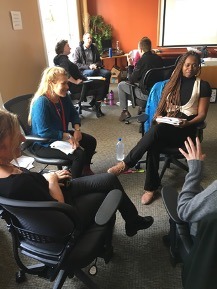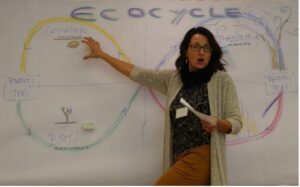By the EDR Team

We’ve all sat through poorly planned meetings. When happening in person, these are the meetings where we fidget in our seats, try to subtly peek at the clock, and wish for more coffee. When held online, these are the times when we secretly surf the web, message with co-workers, or simply turn off our camera and disengage. In both settings, we’re left feeling like our time is being wasted.
As David Straus points out in Managing Meetings to Build Consensus (Consensus Building Handbook, Sage 2000), an effective meeting achieves its goals, leaves participants feeling satisfied with the process, and strengthens relationships. A poorly run meeting, on the other hand, can decrease participants’ motivation, damage credibility, and waste time and money.
When engaging in a collaborative process, a poorly run meeting has the potential to derail the entire effort. With such high stakes, how do we set a meeting up for success?
Both in-person and virtual meetings require deliberate planning, facilitation, and follow-through, often with more time spent in planning than in the meeting itself.
Get notified when new articles are posted to the EDR blog – sign up for our email list »
To provide assistance with planning and facilitating effective meetings, the Wallace Stegner Center Environmental Dispute Resolution (EDR) Program offers cohort-based trainings and recently added two new resources to the Tools & Resources webpage:
- PACER worksheet to think through the key elements of effective meetings (PACER stands for purpose, agenda, code of conduct, expectations, roles & responsibilities)
- Facilitating effective meetings cheat sheet to plan for the different aspects of meeting preparation, facilitation, and follow-up
These two resources, above, include detailed descriptions of the key considerations for planning and executing a well-run meeting. As a brief summary, we at the EDR program suggest:

Before the meeting, the facilitator should consider doing preliminary assessments to inform their plans, and use a framework such as PACER to articulate the meeting’s purpose, agenda, code of conduct, expectations, and roles and responsibilities. Liberating structures can provide helpful ideas for building an agenda and approach that will engage participants. Facilitators should also identify a meeting location and room arrangement that is appropriate for the meeting’s purpose and participants.
During the meeting, the facilitator should ensure that the objectives, roles, and ground rules are clear from the start. The facilitator should let the group do the work, intervene when the group’s effectiveness is at risk, and listen carefully for moments of opportunity.
After the meeting, the facilitator should send out a meeting summary, remind attendees to follow up on action items, and use the meeting outcomes to develop an agenda for the next meeting.
Although planning and facilitating effective meetings takes time, it is well-worth the effort. With careful preparation and follow-through, we can all avoid the pitfalls of a poorly run meeting and keep our stakeholders motivated and engaged, and our collaborative efforts on-track.
We at the EDR Program encourage you to check out and share these resources. We hope they help you and others run effective and engaging meetings, whether online or in person!

